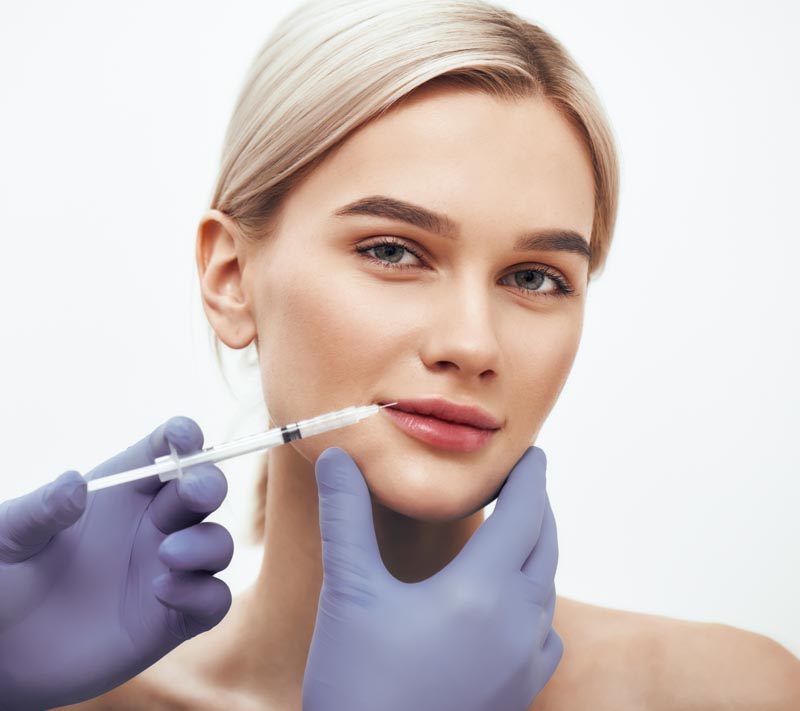Botox

Botox Cosmetic
Banish Wrinkles and Fine Lines with Botox and Dysport
As a person ages in life we progressively develop facial wrinkles. These wrinkles tend to occur in several very constant locations. These locations include: the lateral eyes, the upper nasal region, the forehead and the peri-oral region. Plastic surgeons have various weapons to help erase these wrinkles but one of the most common methods of combating these signs of aging is through the use of either Botox or Dysport.
Neuromodulators can temporarily stop lines and wrinkles by paralyzing the muscles that cause them. There are two primary injectables, Botox and Dysport. At Dr. Shaun Parson Plastic Surgery & Skin Center, both are available and our expert injectors will match you with the best option for your skin and goals. Botox is more widely known because it has been around the longest. It was first available in the US 20+years ago. However, Dysport has been available and FDA-approved since 2009, making both of these injectables proven options for relaxing muscles and achieving smoother skin.
Most clients want to know which is “better,” Botox or Dysport, but it depends on you, your skin concerns, and what you’d like to achieve. The two neuromodulators are very similar. They are minimally invasive and typically offer results that last about the same timeframe (3 – 6 months on average).
Botox
Banish Wrinkles and Fine Lines with Botox and Dysport
As a person ages in life we progressively develop facial wrinkles. These wrinkles tend to occur in several very constant locations. These locations include: the lateral eyes, the upper nasal region, the forehead and the peri-oral region. Plastic surgeons have various weapons to help erase these wrinkles but one of the most common methods of combating these signs of aging is through the use of either Botox or Dysport.
Neuromodulators can temporarily stop lines and wrinkles by paralyzing the muscles that cause them. There are two primary injectables, Botox and Dysport. At Dr. Shaun Parson Plastic Surgery & Skin Center, both are available and our expert injectors will match you with the best option for your skin and goals. Botox is more widely known because it has been around the longest. It was first available in the US 20+years ago. However, Dysport has been available and FDA-approved since 2009, making both of these injectables proven options for relaxing muscles and achieving smoother skin.
Most clients want to know which is “better,” Botox or Dysport, but it depends on you, your skin concerns, and what you’d like to achieve. The two neuromodulators are very similar. They are minimally invasive and typically offer results that last about the same timeframe (3 – 6 months on average).
All About Botox
Both Botox and Dysport have the same active ingredient, botulinum toxin A. This is a toxin produced by the bacteria (not the bacteria itself), and it works by blocking nerve signals to the injected muscles so that they can’t contract. The result of this muscle paralysis is elimination of lines and wrinkles temporarily. After all, lines, wrinkles, and creases that form exclusively when muscles are bunched aren’t going to appear when those muscles can’t move.
Some clients have reported that Dysport tends to last longer than Botox. Others find the opposite to be true. It can be a good idea to switch back and forth between these two neuromodulators to diversify your approach to wrinkle prevention and management. Trying out both is also one of the best ways to determine which injectable you prefer.

All About Botox

Both Botox and Dysport have the same active ingredient, botulinum toxin A. This is a toxin produced by the bacteria (not the bacteria itself), and it works by blocking nerve signals to the injected muscles so that they can’t contract. The result of this muscle paralysis is elimination of lines and wrinkles temporarily. After all, lines, wrinkles, and creases that form exclusively when muscles are bunched aren’t going to appear when those muscles can’t move.
Some clients have reported that Dysport tends to last longer than Botox. Others find the opposite to be true. It can be a good idea to switch back and forth between these two neuromodulators to diversify your approach to wrinkle prevention and management. Trying out both is also one of the best ways to determine which injectable you prefer.

The Dysport Difference
Although Dysport has been available in the US for well over a decade, it was available in Europe way before that—which means there really is no tried and true method of determining which option is “best” since they have both been popular and readily available for quite a long time.
One of the primary differences with Dysport is that it’s more diluted than Botox, which can be a good thing. Dysport simply features smaller protein molecules, which can be tougher for antibodies to break down. This is why some clients might find that the results last a little longer.
Another benefit of the consistency of Dysport is that it makes it easier to treat larger areas. Dysport spreads, making it a great option to treat forehead wrinkles, frown lines, and crow’s feet.
The Dysport Difference

Although Dysport has been available in the US for well over a decade, it was available in Europe way before that—which means there really is no tried and true method of determining which option is “best” since they have both been popular and readily available for quite a long time.
One of the primary differences with Dysport is that it’s more diluted than Botox, which can be a good thing. Dysport simply features smaller protein molecules, which can be tougher for antibodies to break down. This is why some clients might find that the results last a little longer.
Comparing Botox and Dysport
Weight Matters with Neuromodulators
There is also a weight difference when comparing Botox and Dysport. Botox has a lower molecular weight, but Dysport features more protein size variability. That protein size variability in Dysport is another reason it spread so well after injecting it, and sometimes this can mean fewer injections are necessary to achieve the same results. This can be a great perk for those who would like to avoid as many needles as possible during this treatment.
On the other hand, the molecular weight of Botox makes it better for highly concentrated areas like the “angry 11’s” between the brows. Botox is also routinely recommended for targeted sites like below the eyes and around the mouth.
However, Botox and Dysport are also so similar that they can easily be interchangeable. They have the same ingredient, same mechanism, and same safety profile. The best way to choose your neuromodulator is to try them both out and see which you prefer.
Matching Botox or Dysport to Trouble Areas


Botox Treatment, Patient Before/After Photos*
One approach for selecting a neuromodulator is to consider what you’d like to treat. For eye wrinkles, including the “angry 11’s,” Botox might be a great fit. Since it doesn’t spread as much, this small area can be readily treated with the better known of the two products.
Crow’s feet are a little different. These lines spread outward from the corners of the eyes, so Dysport might offer more favorable results. This is an area where spreading can be a great thing.
Forehead lines cover a relatively large area, so this could be an area better treated by the spreading capabilities of Dysport. When neuromodulators spread, the edges of the results feather out beautifully so you can get a very natural look.
Skin Care Products
Medical-grade skin care products are a real game changer!
Learn more about Skin Medica, ZO Skin Health, and Skin Better Science.
Book Now
Scheduling Your Botox or Dysport Appointment

You also need to consider the dose of either Botox or Dysport. Dysport typically requires a higher dose because of its dilution, but the pricing between the two reflects this need. Ultimately, you are going to pay close to the same amount for either Botox or Dysport while receiving similar results because the need for a higher Dysport dose is built into the pricing model. Don’t let the price per unit dictate your decision, because in the end the costs will be nearly identical.
Consultations aren’t required for neuromodulators, but they can be helpful for first-time clients. You can schedule either an appointment or consultation with Parson Skin Center right now by calling the office or completing the online form. Also, remember that the skill of the injector is just as important as the type of neuromodulator and the dose used. Get the results you’ll love by trusting the best. You can also learn more about complementary treatments that are great add-ons, like injectable fillers and Sculptra, during your consultation or appointment.
Book Now
Schedule Your Aesthetics Appointment

Consultations aren’t required for neuromodulators, but they can be helpful for first-time clients. You can schedule either an appointment or consultation with Parson Skin Center right now by calling the office or completing the online form. Also, remember that the skill of the injector is just as important as the type of neuromodulator and the dose used. Get the results you’ll love by trusting the best. You can also learn more about complementary treatments that are great add-ons, like injectable fillers and Sculptra, during your consultation or appointment.



